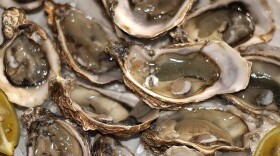A North Carolina State University researcher is using underwater microphones to help better understand the extensive array of animals living in the state’s oyster reefs.
The state has been rebuilding oyster reefs along the coast for decades. Barges haul massive piles of spent oyster shells and other hard materials, like granite marl and concrete, to a reef site and use large water cannons to blow it all off the deck and into the coastal waters.
The spectrograms are helpful because a lot of frequencies we record are inaudible to the human ear. -Olivia Caretti
These artificial habitats provide hard structure for oyster larvae to attach to so they can grow and be harvested.
The North Carolina Department of Environmental Quality’s division of marine fisheries knows the reef program is good for the state’s $2.4 million oyster industry. But it’s still unclear what the larger impact of these reefs are in terms of increasing biodiversity.
“It’s what we call data gaps,” said Jason Peters, supervisor for the state’s oyster sanctuary program.
North Carolina State University Ph.D. student Olivia Caretti is hoping to fill some of those data gaps using a relatively new method for monitoring aquatic life with underwater microphones, known as hydrophones.
“It’s like a little compact torpedo looking thing about the size of your hand,” Caretti said.
Caretti is using these hydrophones to document which animals, beside oysters, use these reefs. And what she’s found so far has been enlightening.

An unstructured muddy bottom in Pamlico Sound, with no oyster reef, is mostly low frequency audio.
“The only sounds you hear are either water movements or low frequency fish calls,” Caretti said.
Life on an oyster reef sounds a lot different. It has plenty of low frequency fish calls, but it also has a lot of high frequency invertebrate activity.
“You can hear some grunts and knocking sounds,” Caretti said. “There are certain type of fish calls and snaps from snapping fish especially.”
Caretti has been recording for two years and has more audio than she could ever listen to. She does most of her analysis by using spectrograms, which are visual representations of the audio.
“The spectrograms are helpful,” Caretti said,” because a lot of frequencies we record are inaudible to the human ear.”
Caretti also uses traditional methods for monitoring oyster reefs, like trapping fish. But these techniques can be invasive and you only get brief snapshots of life on the reef.
By recording around the clock, Caretti can document what species of fish and invertebrates use these reefs and why. For instance, she’s learned oyster toadfish use the reef like a swinger at a singles bar hoping to meet a mate.
“So they’re communicating with each other and also with females of that species too,” she said while listening to scores of oyster toadfish honking in a cacophonous chorus.

Caretti has been tracking the change in biodiversity on theses habitats over time and has found reefs made with shell attract more aquatic life than reefs made out of materials like granite marl or concrete. This could suggest it’s more valuable to dump shells into the water rather than other materials.
Caretti’s findings are still preliminary, but they come at a good time. The North Carolina Coastal Federation announced in August that it wants to grow the state’s oyster industry by more than ten times by 2030, from $2.4 million to $30 million.
And while that might be music to the ears of fishermen, it'll sound a whole lot different when heard through a hydrophone.









